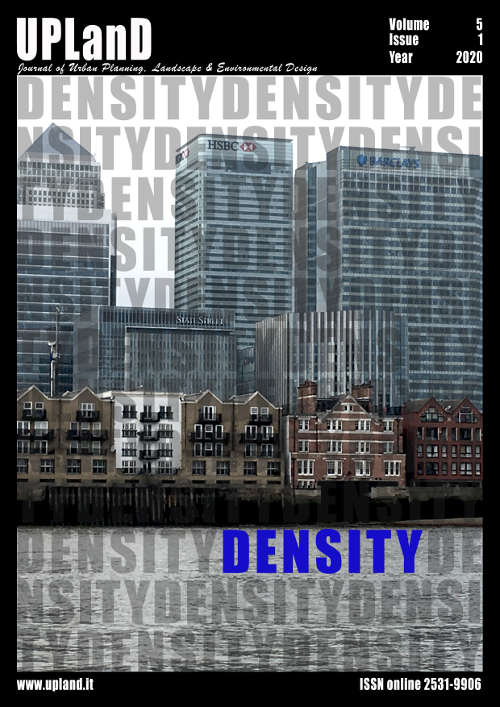Density and sustainability as a new paradigm for urban resilience European programs for territorial adaptation projects
Main Article Content
Abstract
Risk management due to the unstoppable effects of climate change on the territory is an increasingly topical subject in the international scientific debate.
The theme of changing cities involves different disciplinary sectors, so it would not be exhaustive to analyse it from a unilateral point of view.
The contribution proposes a multidisciplinary and multi-scale analysis related to the adaptation measures of urban agglomerations through a socio-economic analysis aimed at achieving a high level of security, efficiency of ecosystems and social inclusion.
Overcoming the sectorial and specialist approach of modernist urbanism is the basis for addressing what appears to be the "challenge" of the new millennium.
It is authors' conviction that the physical transformations of space, in the presence of geomorphological alterations due to climate change, must be based on strategic policies in the medium and long term, shared and articulated at the different levels of government of the territory. In this frame of reference, the question of density merges with the concept of sustainability, overcoming it, becoming a new paradigm of urban resilience
Downloads
Article Details

This work is licensed under a Creative Commons Attribution-NonCommercial-NoDerivatives 4.0 International License.
Authors who publish with this journal agree to the following terms:- Authors retain copyright and grant the journal right of first publication with the work simultaneously licensed under a Creative Commons Attribution License that allows others to share the work with an acknowledgement of the work's authorship and initial publication in this journal.
- Authors are able to enter into separate, additional contractual arrangements for the non-exclusive distribution of the journal's published version of the work (e.g., post it to an institutional repository or publish it in a book), with an acknowledgement of its initial publication in this journal.
- Authors are permitted and encouraged to post their work online (e.g., in institutional repositories or on their website) prior to and during the submission process, as it can lead to productive exchanges, as well as earlier and greater citation of published work (See The Effect of Open Access).
References
Boller, G. (2017) Paesaggio come infrastruttura urbana per la mitigazione del rischio d’esondazione, in Workshop 1, Urbanistica e/è Azione pubblica per la prevenzione dai rischi, Atti XX Conferenza Nazionale SIU, Roma, Planum Publisher.
Braudel, F. (1987). Il Mediterraneo. Lo spazio e la storia, gli uomini e la tradizione. Milano, Italia: Bompiani.
Causone, F. (2019). Le città ai tempi dei cambiamenti climatici. Retrieved March 14, 2019, from: https://www.ispionline.it
Charbonneau, J.P. (2007). Aménagements d’anticipation. Retrieved Juin 25, 2007, from: http://www.jpcharbonneau-urbaniste.com
Department of Economic and Social Affairs Population Dynamics (2017). Probabilistic Projections of World Population Prospects. Retrieved from: https://esa.un.org/unpd/wpp/
Department of Economic and Social Affairs Population Dynamics (2018). Urban and Rural Population del World Urbanization Prospects. Retrieved from: https://esa.un.org/unpd/wpp/
European Commission. (2013). COM 216 The EU Strategy on adaptation to climate change. Retrieved from: https://ec.europa.eu
European Commission – Staff Working Document. (2013). Climate change adaptation, marine and coastal issues, Commission Staff Working Document. Retrieved from: https://eur-lex.europa.eu
European Council. (2000). European Landscape Convention. Florence, Italy.
European Enviromental Agency. (2016). Climate change impacts and vulnerability in Europe 2016. Retrieved from: https://www.eea.europa.eu
European Parliament. (2018). Report on the role of EU regions and cities in implementing the COP 21 Paris Agreement on climate change - Cities and regions. Retrieved from: https://www.europarl.europa.eu
EY & 100RC (2017). Getting real about resilience - 100 resilient cities. Retrieved from: http://100resilientcities.org
Faiella, I. & Malvolti, D. (2019). Il rischio climatico per la finanza in Italia. Rapporto del Gruppo di lavoro 3 dell'Osservatorio italiano sulla finanza sostenibile. Retrieved from: https://www.minambiente.it
IPCC - Intergovernmental Panel on a Climate Change (2013). The Physical Science Basis. Retrieved from: https://www.ipcc.ch
Layman’s report (2013). Costruire città resilienti. Linee guida per l’adattamento al cambiamento climatico. Retrieved from: https://ec.europa.eu
Maciocco, G. (2015), Paesaggi dell’acqua come progetto del territorio sicuro, in Urbanistica Informazioni n.263(S.I.).
Mariano, C. (2012). Progettare e gestire lo spazio pubblico. Roma, Italia: Aracne.
Marino, M. (2017). Urban natures for urban resilience. Time phases design for Changing Cities. In A.Gospodini (Ed.), Proceedings of the international - 3 - Conference on Changing Cities III. Thessaloniki, GR: Grafima Pubblication.
Ministero dell’Ambiente e della Tutela del Territorio e del Mare. (2017). Piano nazionale di adattamento ai cambiamenti climatici. Retrieved from: https://www.minambiente.it
Ministero dell’Ambiente e della Tutela del Territorio e del Mare. (2015). Strategia Nazionale di Adattamento ai Cambiamenti Climatici. Retrieved from: http://www.pdc.minambiente.it
Musco, F. & Zanchini, E. (2013). Le città cambiano il Clima. Venezia, IT: Corila.
Musco, F. & Zanchini, E. (2014), Il clima cambia le città. Strategie di adattamento e mitigazione nella pianificazione urbanistica. Milano, IT: Franco Angeli.
Perra, G. & Venturi, P. (2018). La finanza di impatto per i cambiamenti climatici. Retrieved from: http://finanzasostenibile.it
Ricci, M. (2002). Prevedere mutamenti e rischi. In A. Clementi (Ed.), Interpretazioni di paesaggio. Milano, IT: Meltemi editore.
United Nations. (2015). United Nations Framework Convention on Climate Change. Retrieved from: https://unfccc.int
Vejle’s Resilient Strategy. (2013). Vejle Kommune. Retrieved from: https://www.vejle.dk

